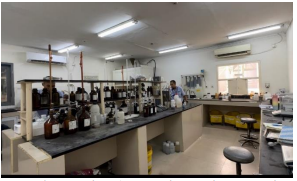The Making of Biobriquettes with Carbonization Method by Utilizing Sludge Cake and Wood dust from the Pulp Industry

Submission to VIJ 2024-02-20
Keywords
- Briquettes, Sludge Cake, Wood Dust, Eucalyptus pellita, Black Liquor
Copyright (c) 2024 Masnun Lintang Alnasyah, Renilaili, Ch. Desi Kusmindari, Yanti Pasmawati, Hasmawaty AR

This work is licensed under a Creative Commons Attribution 4.0 International License.
Abstract
Sludge cake as a solid waste that is rarely used from residual sludge from Waste Water Treatment Plants is one source of biomass from the pulp and paper industry which has the potential to be used as renewable energy. Analysis of biobriquette characteristics includes: moisture content, ash content, volatile matter, bound carbon, and calorific value. The results of this research show that the best combination of biobriquettes is biobriquettes with a composition of 40% sludge cake, 50% Eucalyptus pellita wood dust, and 10% black liquor adhesive which has a moisture content of 2.12%, ash content of 19.33%, volatile matter 28 .99%, calorific value of 4915.69 kJ/gr, and fixed carbon content of 49.63%.
References
- Susantini, NM, & Oktariani, R. (2021). Utilization of Sludge with a Mixture of Black Liquor and Coconut Shell as a Material for Making Biobriquettes. Journal of Applied Science (Japps), 3(1), 011-019. Retrieved fromhttps://doi.org/10.36870/japps.v3i1.227
- Gavrilescu, D. (2008). Energy from biomass in pulp and paper mills. Environmental Engineering and Management Journal, 537-546.
- Kodoati, RJ (2008). Integrated Water Resources Management. Yogyakarta : ANDI.
- Sudarsono, Putri ER (2010). Eco – Briquette from Coffee Skin Composite, IPAL Sludge PT. SEER and LDPE Plastic Waste. Final Project Report for the Department of Environmental Engineering FTSP – ITS. Surabaya.
- Hamsar, H., Helwani, Z., & Bahruddin, B. (2019). Thermodynamic Simulation of Gasification of Black Liquor Kraft Soluble Pulp Factory as a Renewable Energy Source. Journal of Science and Technology, 16(2), 48. Retrieved fromhttps://doi.org/10.31258/jst.v16.n2.p48-53
- Tang, MM & Bacon, R. Carbonization of cellulose fibers-I. Low temperature pyrolysis. Carbon NY 2, 211–220 (1964).
- Sunardi, Djuanda, and Mandra MAS / International Energy Journal 19 (2019) 139 – 148.
- Onu F., Sudarja, Rahman NBM 2010. Measurement of the Calorific Value of Charcoal Briquette Fuel Combination of Nutmeg Shells (Myristica Fragan Houtt) and Palm Oil Waste (Elaeis Guenensis). National Seminar on Mechanical Engineering Yogyakarta: Muhammadiyah University.
- Takeuchi, Yahsito, Introduction to Chemistry. Tokyo: Iwamani Publishing Company (2006).
- Yuniarti, Theo YP, Faizal Y, Arhamsyah. 2011. Charcoal Briquettes from Meranti Wood Wood dust and Galam Wood Charcoal. J. Forest Products Industry Research. Vol 3(2):37-42